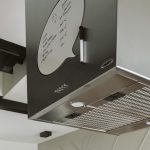500 cfm is generally sufficient for a range hood.

Credit: www.amazon.com
The Importance Of Cfm In Range Hoods
When it comes to choosing the right range hood for your kitchen, the cubic feet per minute (cfm) rating is a crucial consideration. Cfm refers to the amount of air that a range hood can move within a minute, which directly affects its effectiveness in ventilating your kitchen.
Understanding the importance of cfm is essential in ensuring that you select a range hood that meets your needs.
Understanding Cfm (Cubic Feet Per Minute)
- Cfm is a measurement of the volume of air that a range hood can exhaust or move in a minute.
- The higher the cfm rating, the more air the range hood can remove from your kitchen, resulting in better ventilation.
- Cfm is directly related to the size of your kitchen as you need a range hood with a higher cfm rating for larger spaces.
Why Cfm Is Crucial For Effective Ventilation
- Effective ventilation is vital in removing smoke, grease, steam, and other airborne pollutants from your kitchen.
- A range hood with an adequate cfm rating ensures that these pollutants are efficiently exhausted, enhancing the air quality in your kitchen.
- Cfm plays a significant role in preventing the buildup of moisture, reducing the risk of mold and mildew growth.
The Correlation Between Cfm And Smoke/Odor Removal
- Cfm is directly linked to the range hood’s ability to remove smoke and odors from your kitchen.
- Range hoods with higher cfm ratings are more effective in capturing and exhausting smoke and odors.
- In order to effectively remove smoke and odors, it’s recommended to choose a range hood with a cfm rating that matches the size of your kitchen and the type of cooking you do.
By understanding cfm and its importance in range hoods, you can make an informed decision when selecting the right one for your kitchen. Remember to consider the size of your kitchen, the type of cooking you do, and ensure that the cfm rating of the range hood aligns with your specific requirements.
With the right range hood, you can enjoy a cleaner and odor-free kitchen environment.
Determining The Optimal Cfm For Your Kitchen
—————————————————
The size and layout of your kitchen, the types of cooking you do, and other factors all play a role in determining the optimal cfm (cubic feet per minute) for your range hood. To ensure proper ventilation and effective removal of cooking odors, grease, and heat, it’s important to choose a range hood with the right cfm for your specific kitchen setup.
Let’s take a look at the key factors to consider when selecting the cfm for your range hood.
Factors To Consider When Selecting The Cfm For Your Range Hood:
- Size and layout of the kitchen:
- A larger kitchen or an open-concept layout may require a higher cfm to effectively vent the cooking fumes.
- In compact kitchens or those with limited space, a lower cfm may suffice.
- Consider the square footage of your kitchen to determine the appropriate cfm range for your range hood.
- Types of cooking done in the kitchen:
- Different cooking methods produce different levels of smoke, steam, and odors.
- If you frequently cook with high-heat methods like frying or grilling, a higher cfm may be necessary to handle the increased smoke and grease.
- Ceiling height and duct length considerations:
- Higher ceilings may require a range hood with a stronger cfm to effectively capture rising smoke and heat.
- Longer ductwork can affect the airflow and require a higher cfm to compensate for the additional resistance.
- Balancing cfm with energy efficiency:
- While it’s important to have sufficient cfm for effective ventilation, it’s also crucial to consider energy efficiency.
- Higher cfm consumes more energy, so finding the right balance can help save on electricity costs.
- Look for range hoods with energy-saving features such as variable speed settings or sensors that adjust cfm based on cooking activity.
By taking into account the size and layout of your kitchen, the types of cooking you do, the ceiling height, duct length, and energy efficiency considerations, you can determine the optimal cfm for your range hood. Choosing the right cfm will ensure a clean and comfortable kitchen environment, allowing you to cook without worrying about lingering cooking odors or excessive heat.
Keep these factors in mind when selecting a range hood to achieve optimal performance and ventilation in your kitchen.
The Advantages And Limitations Of A 500 Cfm Range Hood
A 500 cfm range hood can be a suitable option for many kitchens, providing effective smoke and odor removal during moderate cooking sessions. Furthermore, it offers a range of advantages and limitations that are important to consider before making a purchase decision.
Let’s dive into the key points regarding the pros and cons of a 500 cfm range hood.
Pros Of A 500 Cfm Range Hood
- Effective removal of smoke and odors with moderate cooking: With its 500 cfm (cubic feet per minute) airflow capacity, this range hood can effectively capture and eliminate smoke and odors produced during everyday cooking activities. It ensures a cleaner and more pleasant cooking environment in your kitchen.
- Energy-efficient option for smaller kitchens: If you have a smaller kitchen space and do not engage in heavy-duty cooking, a 500 cfm range hood can be an energy-efficient choice. It effectively ventilates the air without consuming excess energy, helping you save on your energy bills.
- Cost-effective choice compared to higher cfm models: When it comes to range hoods, higher cfm models are available, but they often come with a higher price tag. A 500 cfm range hood provides a balance between performance and affordability, making it a cost-effective option for those who require efficient ventilation without breaking the bank.
Limitations Of A 500 Cfm Range Hood
- Inadequate for large kitchens or heavy-duty cooking: If you have a large kitchen or frequently engage in heavy-duty cooking that generates a significant amount of smoke and odors, a 500 cfm range hood may not be sufficient. Larger kitchen spaces or intense cooking sessions may require a range hood with higher cfm capacity to effectively capture and eliminate smoke and odors.
- Limited smoke and odor capture for intense cooking sessions: Similarly, when it comes to intense cooking sessions such as frying, grilling, or cooking with strong spices, a 500 cfm range hood may not provide adequate smoke and odor capture. The limited airflow capacity may struggle to keep up with the amount of smoke and odors produced, resulting in less effective ventilation.
- Potential issues with ductwork and airflow restrictions: Another limitation to consider is that a 500 cfm range hood may encounter issues with ductwork and airflow restrictions. The relatively higher airflow capacity can lead to more air resistance in the ductwork, potentially causing airflow restrictions and reduced performance. It is crucial to ensure proper installation and maintenance to overcome these potential issues.
A 500 cfm range hood offers several advantages such as effective removal of smoke and odors during moderate cooking, energy-efficiency for smaller kitchens, and cost-effectiveness compared to higher cfm models. However, it may not be suitable for large kitchens or heavy-duty cooking, limited smoke and odor capture during intense cooking sessions, and potential issues with ductwork and airflow restrictions.
Consider your kitchen size, cooking habits, and ventilation needs to make an informed decision when selecting a range hood for your home.
Boosting The Power Of A 500 Cfm Range Hood
Is 500 cfm enough for a range hood? This is a common question many homeowners ask when considering their kitchen ventilation options. While a 500 cfm (cubic feet per minute) range hood can effectively remove smoke and odors from your kitchen, there are ways to enhance its power and efficiency.
In this section, we will explore power-boosting alternatives, enhanced ventilation techniques, the use of charcoal filters and recirculating kits, proper placement and installation, as well as supplementary strategies to augment the performance of a 500 cfm range hood.
Exploring Power-Boosting Alternatives To A Higher Cfm Range Hood:
- Utilize enhanced ventilation techniques for better smoke and odor removal.
- Consider the use of charcoal filters and recirculating kits.
- Make sure the range hood is properly placed and installed.
- Explore supplementary strategies to improve the efficiency of a 500 cfm range hood.
Enhanced Ventilation Techniques For Better Smoke And Odor Removal:
- Remove barriers and obstructions from the cooking area.
- Optimize stove positioning for improved airflow.
Use Of Charcoal Filters And Recirculating Kits:
- Install charcoal filters to effectively trap and neutralize odors.
- Consider using a recirculating kit to improve the range hood’s efficiency.
Proper Placement And Installation Of The Range Hood:
- Position the range hood at the appropriate height above the cooking surface.
- Ensure proper venting to the exterior of your home for optimal performance.
Supplementary Strategies To Augment The Efficiency Of A 500 Cfm Range Hood:
- Clear any obstacles that may impede the airflow in the kitchen.
- Keep the kitchen well-ventilated with open windows or an exhaust fan.
- Upgrade your kitchen ventilation system, including ductwork, if necessary.
By following these tips, you can boost the power and effectiveness of your 500 cfm range hood, ensuring a clean and fresh kitchen environment. Remember, it’s not just about the cfm rating but also implementing proper ventilation techniques and making the most of the available options for smoke and odor removal.
Other Factors To Consider For Effective Kitchen Ventilation
The role of other ventilation sources in the kitchen:
- It’s not just about the range hood when it comes to effective kitchen ventilation. Other sources of ventilation play a crucial role in maintaining a healthy and odor-free kitchen environment.
- Kitchen windows can provide natural ventilation by allowing fresh air to circulate and stale air to escape. Opening windows during cooking can help remove smoke, odors, and excess heat.
- Air purifiers and hvac systems can also contribute to improving kitchen air quality. These devices filter out airborne particles, such as cooking odors and allergens, ensuring a clean and breathable atmosphere.
- The placement of these ventilation sources is important. Window placement should be strategic to allow cross ventilation, while air purifiers and hvac systems should be positioned in areas where they can effectively filter the air.
Maintenance and cleaning tips for optimal range hood performance:
- Regular filter replacement or cleaning is essential for the efficient functioning of a range hood. Depending on the type of hood, filters should be replaced every 3 to 6 months or cleaned regularly to remove grease and grime buildup.
- Clearing grease buildup from the fan and ductwork is crucial to prevent clogging, reduce fire hazards, and maintain proper airflow. Grease can accumulate over time and hinder the hood’s effectiveness, so it’s important to clean these areas thoroughly.
- It’s recommended to use a mixture of warm water and mild detergent to clean the range hood’s exterior surface. Avoid abrasive cleaners or scrubbing brushes that could damage the hood’s finish.
- Pay attention to the control panel and buttons, as these areas can collect dust and food particles. Regularly wipe them down with a damp cloth to prevent build-up.
Incorporating these factors into your kitchen ventilation routine can help ensure that your range hood operates effectively, keeping your kitchen fresh, clean, and odor-free. Remember to prioritize regular maintenance and cleaning to maximize the longevity and performance of your range hood.
Frequently Asked Questions On Is 500 Cfm Enough For Range Hood
Is 500 Cfm Enough For A Range Hood?
A range hood with 500 cfm (cubic feet per minute) is generally sufficient for most cooking needs. It can effectively remove smoke, odors, and grease from your kitchen. However, if you frequently do heavy cooking or have a larger kitchen, you may want to consider a hood with higher cfm for better ventilation.
What Is Cfm In A Range Hood?
Cfm stands for cubic feet per minute and it is a measure of the amount of air that a range hood can move in one minute. It indicates the power and effectiveness of the ventilation system. A higher cfm means the range hood can remove more smoke, odors, and grease, providing better air quality in your kitchen.
How Do I Determine The Right Cfm For My Range Hood?
To determine the right cfm for your range hood, consider the size of your kitchen and the type of cooking you do. As a general guideline, the cfm should be at least the same as the total btu rating of your range or cooktop.
For heavy cooking or larger kitchens, you may want to choose a hood with a higher cfm for better ventilation.
What Happens If The Cfm Of The Range Hood Is Too Low?
If the cfm of your range hood is too low for your cooking needs, it may not effectively remove smoke, odors, and grease from your kitchen. This can result in poor air quality, lingering odors, and increased grease buildup in your kitchen.
It’s important to choose a range hood with an adequate cfm to ensure proper ventilation.
Can I Increase The Cfm Of My Existing Range Hood?
In some cases, it may be possible to increase the cfm of your existing range hood by upgrading the motor or ductwork. However, it is recommended to consult a professional for guidance as there are limitations based on the design and capacity of the hood.
Upgrading to a new range hood with higher cfm is often a more effective solution.
Conclusion
Determining whether 500 cfm is enough for a range hood depends on various factors. The size of your kitchen, the type of cooking you do, and the layout of your space all play a role in deciding the appropriate cfm level for your ventilation needs.
It is essential to consider the size of your stove and the amount of heat, smoke, and odors produced during cooking. While 500 cfm may be sufficient for some smaller kitchens with minor cooking activities, larger kitchens or those with heavy-duty cooking may require a higher cfm rating to effectively eliminate airborne pollutants.
Remember to consider the noise level as well, as higher cfm models tend to be louder. Ultimately, it is best to consult with a professional or refer to the manufacturer’s recommendations to ensure you choose the right cfm level for your range hood to maintain a clean and healthy kitchen environment.

Freda is a passionate foodie and kitchen gadget enthusiast. With over 10 years of experience in the culinary industry, Freda brings her expertise in testing and reviewing kitchen gadgets.





